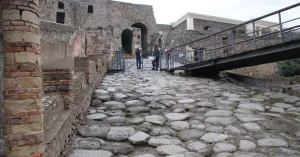It’s not just a random entrance—it’s a doorway into history, both literally and figuratively. But what’s even cooler is that Porta Marina is more than just a set of old stones; it has its own story, and one that’s closely tied to Pompeii’s vibrant past.
Let me take you back to the moment I stood at Porta Marina, about to step into the ancient world. I had no idea at the time that the name Porta Marina translates to "Sea Gate"—yep, the Romans loved naming things quite practically. This gate once led to the bustling port that connected Pompeii to the sea, which made it one of the most important entrances to the city. Today, that sea is a bit farther off, but back in ancient times, you would’ve looked out and seen ships coming and going, bringing goods, travelers, and news from all over the Mediterranean.
As I stood there, taking in the ancient stone archway that had seen countless merchants, travelers, and citizens pass through its threshold, I realized that Porta Marina was much more than just an entrance—it was Pompeii’s lifeline to the outside world.
The History of Porta Marina
Built around the 3rd century BC, Porta Marina was one of Pompeii’s seven main gates, each leading to different parts of the surrounding area. But this one? This was the gate to the sea. Imagine being a merchant back in the day, arriving by boat, unloading your wares, and stepping through Porta Marina into the bustling city. If you were lucky, maybe you were even carrying some exotic spices or silks from far-off lands, and Pompeii’s citizens would flock to your stall to get a taste of the outside world.
But Porta Marina wasn’t just for merchants and sailors. Pilgrims and travelers who had heard tales of Pompeii’s grandeur would have entered through this very gate, probably with wide-eyed wonder (just like me) as they set foot in the city for the first time. This gate was a point of arrival and departure, linking Pompeii’s lively streets to the sea beyond.
Two Tiers, Double the Importance
Here’s something you might not know about Porta Marina—it’s actually a double gate, with two tiers. The lower section was for pedestrians, while the upper was designed for carts and animals. I can picture it now: ancient Romans on foot bustling through the lower entrance, maybe carrying baskets of fresh produce, while the upper gate would have clattered with the wheels of carts loaded with goods.
When I learned this tidbit from my archaeologist guide, I had one of those lightbulb moments—so that’s why the streets have those raised stones (basically ancient Roman crosswalks). They were built for all the carts rolling in through Porta Marina.
The gate's dual design was ingenious, allowing the flow of traffic to move smoothly between the city and the port. Can you imagine trying to navigate the crowded streets of Pompeii with carts and animals jostling alongside pedestrians? The Romans were nothing if not clever engineers.
Porta Marina’s Story After the Eruption
Like the rest of Pompeii, Porta Marina was buried in the volcanic eruption of 79 AD. But remarkably, it survived almost intact, probably because it was partly covered by ash and debris from Vesuvius, which actually helped preserve it. When the city was rediscovered in the 18th century, Porta Marina became one of the first major entrances through which archaeologists and explorers began their excavations. In a way, Porta Marina once again became the gateway to Pompeii—this time, for the modern world.
I couldn’t help but marvel at how this stone gateway, which had once welcomed merchants, travelers, and citizens of ancient Pompeii, was now welcoming us—modern-day travelers looking to step back in time. Walking through that gate, I felt like I was crossing the threshold into an entirely different world. And while much of the city is still in ruins, standing under the shadow of Porta Marina made me feel like the connection between past and present was stronger than ever.
Why Porta Marina Matters Today
Today, Porta Marina is one of the most popular entry points for tourists, but its historical significance is what makes it special. Stepping through it isn’t just about entering Pompeii’s ruins—it’s about walking in the footsteps of those who lived and thrived in this ancient city. Every stone in that gate holds the memory of the thousands of people who passed through it over centuries, from prosperous traders to doomed citizens fleeing Vesuvius’ wrath.
The moment I walked through Porta Marina, I felt like I wasn’t just visiting a historical site—I was entering a living, breathing story. From that point on, every ruin, every house, every street felt like part of an epic tale, and Porta Marina was my entry into it.
So, when you go to Pompeii (and trust me, you should), make sure to take a moment at Porta Marina. Stand there for a second and let the weight of history sink in. Imagine the sounds of carts rattling, the chatter of traders, the sight of ships in the distance. It’s not just an entryway—it’s a portal to the past, waiting to transport you to the world of ancient Rome.
Thank you for reading and make sure to subscribe. We're constantly exploring new destinations and share our stories, tips, and the beauty we discover along the way.


